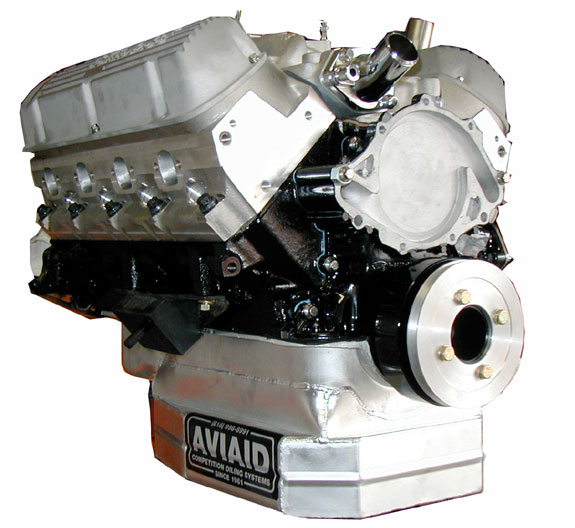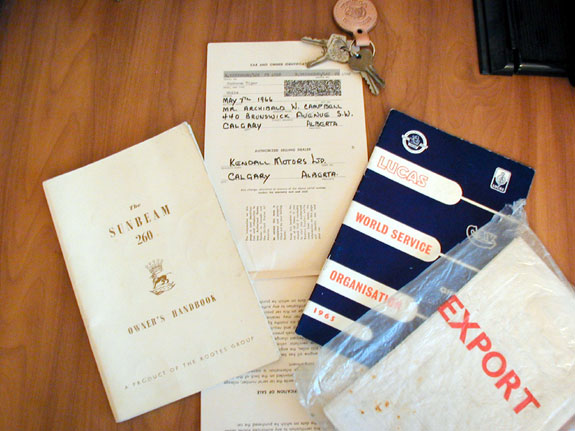A 350 Lunati for a Tiger!

An Article by Tim Ronak
February, 2002
Preface: Tim Ronak has started the first chapter in a series of articles on his stroker motor project. Tim is a fine author, and provides great pictures in this and previous articles. We can wait with anticipation for the rest of this entertaining and educational treatise on his fantastic project.
Editor
Page 1
Why I put a Lunati 350 Stroker into a Tiger?
How I found “IT” (My Tiger)
I have played with Hot Rods and fast cars my whole life but had sold pretty much everything off to permit me to attend University in 1990. During School I worked with my Brother-in-law Bob Rutter to build a budget GT-1 Camaro that we campaigned very successfully. After moving away for a new job opportunity I went about 5 years with no real motorsport activity. The “itch” became too great and I started to search for something that was small, a convertible and powered by a Chevy V-8. The only cars that fit were Corvettes and, if I stretched Chevy powered to include GM powered, the only other car that excited me was a 1966 GTO convertible. I looked for a while for one and found that GTOs were just too expensive for my meager budget. A friend of the family had owned a 1967 Tiger since about 1973 that required rebuilding and not knowing really what it was I looked at it and for the sum of $5000 Canadian seemed to be a little rich for something that needed a complete rebuild and to just drive it home would need a new brake system as well as a carburetor rebuild if it would even run after sitting for 5 years outside. I later found out after researching the Tigers that I really blew it, as it was one of the rare Tiger IIs with several LAT options and was worth every penny if not more. Once I realized this I went back to express my desire to acquire it only to find he had sold it sight unseen to someone in Texas through Hemmings for $5000 US, literally the day before. Now that I was hooked I started to look for other Tigers in and around Calgary and Vancouver with little luck. I found several but in every case they had been so “personalized” or cut up that I really was not interested. My Dad by chance finally saw one in the Local “Bargain Finder Press” and called mpt-images/Ronak350owners-manual.jpghe guy up. I looked at the car and it was priced at $25,000 CND and I felt it was a little over priced for the condition, which was pretty clean and unmodified except for someone’s idea of a dressed up interior. It was complete with the original owners and servicing record manual listing the selling dealer in Calgary as “Kendall Motors Ltd” a Calgary Chrysler Dealer as well as the original purchaser a Mr. Archibald W. Campbell of 440 Brunswick Avenue S.W. Calgary on May 7th 1966.

Original Papers
It also had the original Rootes keys, Hard top, Aircleaner and wheels with polyglass tires and hubcaps. AND it was listed in TBON with the current registered owners name!!!! It would start and run but not move as the clutch did not work and he had already put in a new slave cylinder so we negotiated down about $10 K and we struck a deal. So I towed it home and got to work, Diagnosis …... It needed the clutch arm repaired as it had folded in half due to the pressure of the Borg and Beck styled hi-pressure clutch pressure plate installed when the engine was rebuilt some 7 years ago. A little work with a Mig Welder and three hours later the clutch was repaired and I had my second ride in an actual Tiger. It was Dark, Cold and Wet and WOW It would absolutely boil the tires on wet pavement. I was very excited!
I drove it around for the summer and while it was very exhilarating to drive it was FAR from what I was used to power wise. I drove the car, as it was with minor cosmetic and rubber seal related improvements, until strangely after racing a Miata (and winning cleanly) a funny valve train “type” noise appeared. The engine had already been rebuilt about 15,000 miles ago on a budget by the previous owner and the volume of the noise indicated it would need a complete rebuild again and as it was already bored to .030 based on the receipts for pistons, I would need to find another standard 260 block. YEAH RIGHT !! My decision was that if I were going to build it over again I needed to set a performance goal to determine what my ultimate end point would be.
MY GOAL: “To have enough power to deface public property … at will!”
My decision was to look for some combination that would provide about 400 HP with about 400 lb.ft. of torque at under 6000 RPM. I figured that at 6.25 pounds per horsepower I was likely to exceed the Hennesy Venom 500 Viper (500HP at 3650 lbs) numbers of around 7.3 pounds per horsepower. I reached this low RPM version decision as the car was originally configured for low overall RPM at cruising speed with the factory selected gear ratios resulting in a 2500 – 3500 cruising range with ample torque. I plotted out the math and the torque curve for my potential combination and it is very flat with over 325 lb ft available from 2000RPM through to 6000RPM with a peak of about 395lb ft. I really liked the idea of a low RPM torque monster. Another reason to stay under 6000 was that every time I exceeded the 6500 RPM threshold in the past, I wound up with a car that became relatively undependable as it would mysteriously break parts at “inconvenient” times like … when my spouse was driving it and I was out of town and it was raining and no one would stop and she had to walk and she had groceries to carry and …well you get the idea.
The desired operating range for the engine then would become 2500 – 6500 RPM with desired peaks for the torque and HP curves peaking at 4500 RPM and 5700 RPM. With this in mind I started to select the combination of parts I would use. I decided after much experience with Chevy’s and building 383 CI Strokers that I would like a Stroker engine based on a Ford 302 so that it would be a bolt-in conversion and I would not have to cut the car up at all. In the end I needed to make a small amount of clearance in the valve cover areas of the firewall to facilitate valve lash adjustments and is detailed in another article. The 5.0 block would require going to a six-bolt bell housing, but that was OK because I had one. Everything was chosen around the operating range I was intending to use. As I was on a budget I started to collect the parts I would need to be able to build the engine exactly as I wanted. The popularity of the Ford 5.0 hydraulic roller cam engine forced me to choose this as a starting point as there is a dirth of aftermarket parts available. I found a 1990 5.0 HO motor as a starting point and acquired it complete. After deciding on the stroker I could have saved a few dollars by just buying the block alone but hindsight is always 20/20. One thing I did learn is that once I selected the parts that would be best for the application I did not compromise with something to get by and consider upgrading later. I learned that this was a false economy long ago and bought the best I would ever intend to buy up front. It just took longer to save the dough, which is OK because I am relatively patient.
My witty wife Beth wrote me a limerick for my 40th birthday while I was in process of building my new power plant.
Ode to Tim (or Sunbeamer)
Your clutch is weak and tired, your gaskets old and worn.
Who would have thought at 40, there would be so much to mourn.
But though the oil pan’s leaking, and push rods kind of limp,
The fact you’re down on horsepower does not make you a wimp.
‘Cause the secret of a Rootes man who finds he’s getting older,
Does’nt worry about his “exhaust”ion, he just rebuilds his motor.
Choose My Stroke Combination
I started with the 1990 5.0 HO block and had it tanked and rough bored for a .030 overbore. I purchased the Lunati EA-31 Flat Top stroker kit that delivers 349.503 (350) cubic inches with a 4.030 bore and a 3.425 inch stroke as my stroker motor combination. This has a little more stroke than a 347 at an extra .0250 and past experience has taught me that as stroke increases it is easier to build low RPM torque. This seems to be true regardless of the Rod / Stroke ratio provided you stay above 1.55:1 ( at lower ratios it seems that you start to defeat the gain with the extra side loading of the pistons). It had a low Rod/Stroke ratio of 1.577 as compared to a stock 350 Chevy at 1.638 but better than a stock 1970 400 Chevy at 1.507 or Big Block Chevrolet. It is noteworthy that I believe Big Block Chevys are around 1.50:1 although I am unable to recall exactly. The Lunati 357 kit dropped me below my arbitrarily chosen 1.55:1 ratio so I decided to run with the 349 Kit from Lunati. With these kits side loading of the piston and stresses to the rod assemblies increase and it is very important to obtain QUALITY durable rods and pistons. The Lunati street race rods are warranted up to HP levels of 450 and the pistons provided are of an excellent forged variety with minimal exposed skirt. The stacked height of the rod Stroke and deck height require that the wrist pin slightly intrudes into the lower oil ring land. Lunati addresses this with a lower machined ring that acts as a support/spacer for the lower edge of the oil rings. It is a rather ingenious way of dealing with this issue as I have run pistons with insert pieces as well as exposed oil rings and the design of this arrangement looks really good. (Sorry I lost the Photos) With quality pistons, tight clearances and good oil the extra side loading should not be a problem with the semi-skirtless design of the pistons. Typically the longer the rod or the higher the rod stroke ratio the better a particular combination will be at producing torque as a longer rod increases dwell at TDC and the longer stroke increases the fulcrum arm to the center of the crank and should permit more rotation force for a given combustion cycle. It is my belief that as Rod stroke ratios increase an engine sensitivity to timing decreases. This may mean that the combination will be “picky" about where the timing is kept. Of course when we dyno this we will find out for sure.
I also chose to run 61 cc Trick Flow Twisted Wedge heads to yield just a 10.023:1 compression ratio with a .010 deck height and -.462 cc valve reliefs. Lunati allowed me to substitute the Standard Flat Top pistons with the Twisted Wedge Flat Top versions for no extra cost.
|
Anyone who would like to contribute to this effort should contact us at Editor E-Mail. Thank you. |
 **
**

